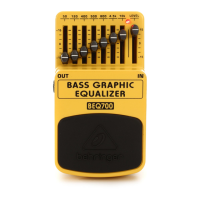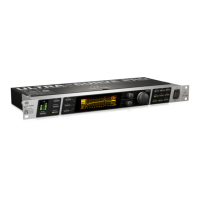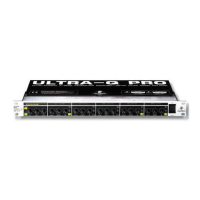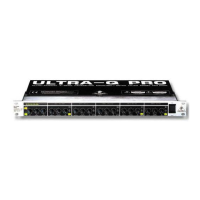8 FEEDBACK DESTROYER FBQ1000 User Manual
(5) With the JOG WHEEL, a continuous rotary control, you can freely edit
the selected parameters. Turn the wheel clockwise to increase the values,
orcounterclockwise to reduce them.
(6) With the FILTER SELECT key activated, you can use the Jog Wheel to select
one of the 12 lters per channel. Subsequently, you can edit the lters.
(7) The FILTER MODE key gives you access to the four operating modes for the
individual lters: “O mode (OF)”, “Parametric EQ (PA)”, “Single-Shot
mode (SI)” and “Auto mode (AU)”. Please read chapter 6 “Operating Modes
of the FBQ1000”.
◊ Pressing the FILTER MODE and GAIN keys simultaneously allows you
to adjust the sensitivity of the feedback suppression trigger circuit.
The setting range is from -3 through -9 dB and can be adjusted with the
JOG WHEEL. The default value is -6 dB, as this setting usually delivers
the best results.
(8) Use the ENGINE L key to select the left audio channel.
(9) Use the ENGINE R key to select the right audio channel. If you wish to
process both channels at the same time (Couple mode), press both Engine
keys together. In Couple mode both ENGINE LEDs light up. Whenever
you edit one of the two audio channels and then switch to Couple mode,
theparameters of the active channel will be copied to the other, i.e. if you
press ENGINEL before ENGINER, left will be copied to right.
Items (10) through (13) refer to Parametric EQ mode only
(see chapters 5 and 7.3).
(10) Press the FREQUENCY key to select the frequency you wish to process.
Theadjustable frequency range is from 20 Hz through 20 kHz, which are split
up by the FBQ1000 into the 31 standard ISO values of a graphic equalizer
(seechapter 11.1 in the appendix).
(11) The FINE key allows you to ne tune the standard ISO frequencies (in1/60-
octave steps), within a tuning range of 1/3 octave (-9/60 to +10/60).
(12) BANDWIDTH determines the lter bandwidth (Q factor) of the selected
lter. This adjustable lter quality ranges from 1/60 octave to 2 octaves
(120/60 octave).
(13) The GAIN key sets the desired boost/cut of the selected lter in
dB(+16dB/-48 dB).
(14) The IN/OUT key allows for optional bypassing of the parametric lters or
all lters. By shortly pressing the IN/OUT key, only the Parametric EQ
lters will be deactivated, and the green LED goes out. Hold down the key
for about two seconds to deactivate all lters. This “Total Bypass” mode is
indicated by the cyclic ashing of the green LED. Another short IN/OUT key
press reactivates all lters. Additionally, the LED ashes when relevant MIDI
data are being received.
◊ If the control LED of the IN/OUT key flashes, all functions (including all
automatic filters used for feedback suppression) are disabled
(“Total Bypass”). In all other modes, at least the Single-Shot and Auto
filters are active (“Bypass”).
◊ Please use the “Total Bypass” function only with caution, because the
deactivation of the filters possibly unlocks suppressed feedback.
(15) Any modications made to a preset can be stored with the STORE key,
inaccordance with the number shown by the Display. Ten presets are
available on the FBQ1000. Press the IN/OUT and STORE keys simultaneously
to enter MIDI Setup mode.
(16) Use the POWER switch to switch the FEEDBACK DESTROYER on or o.
(22)
(20)
(19) (17)(21) (18)
Fig. 4.3: Rear panel connectors and control elements
(17) Use the OPERATING LEVEL switch to change from home recording level
(-10 dBV) to studio level (+4 dBu), and vice versa. The level meters are
adapted automatically to the selected nominal level, so that the FEEDBACK
DESTROYER will always work in its optimum operating range.
(18) These are the balanced INPUTS of the FBQ1000, which are on ¼" TRS and
XLR connectors.
(19) The two OUTPUTS of your FEEDBACK DESTROYER are also on balanced ¼"
TRS and XLR connectors.
(20) SERIAL NUMBER. Please take the time to ll in and return the warranty card
within 14 days after the date of purchase, so as to benet from our extended
warranty. Or use our online registration option available on the World Wide
Web at behringer.com.
(21) The FBQ1000 features a complete set of MIDI functions. In addition to the
usual MIDI IN and MIDI OUT ports, the MIDI THRU allows you to loop
through MIDI data.
(22) FUSE HOLDER / VOLTAGE SELECTOR. Please make sure that your local
voltage matches the voltage indicated on the unit, before you attempt to
connect and operate the unit. Blown fuses may only be replaced by fuses of
the same type and rating. Some models allow for inserting the fuse holder
in two dierent positions, in order to switch over from 230-V to 115-V
operation, and vice versa. Please note that for 115-V operation outside
Europe, you need to use a fuse of a higher rating (see chapter 1.2). Use the
enclosed power cord to connect the unit to the mains.
5. FBQ1000 Architecture:
Presets, Filters, Operating Modes
In order to avoid confusion, let us give you a concise description of the FBQ1000’s
operating principle, so as to make the three relevant points clear right from the
start. Example: You have set up your P.A. system and connected all signal sources
to the console. The FBQ1000 has been inserted into the monitor path (see g.2.1)
or in single channel or sub-group inserts (see g. 2.2); afterpower-up preset
1was loaded with the JOG WHEEL. Now, you can start to purposefully produce
feedback, as described in chapter 3. Depending on the room acoustics,
variousfeedback frequencies can occur. What exactly does the FBQ1000 do?
As can be seen from table 11.3, each of the ten presets on your FBQ1000
comprises 24 separate lters, which can, however, be set to dierent
operating modes: In our example, the rst nine lters of the selected preset
are set to Single-Shot mode (“SI”, see chapter 6.3). This mode is designed
to detect feedback frequencies at xed resonance values, and to suppress
them consistently. So, these lters cannot be unlocked (status “LO” (locked)).
Their bandwidth and gain reduction can be adapted if required, however, the
frequency setting remains the same. In our example, the FBQ1000 is used to
prevent nine xed frequencies from “making trouble”.

